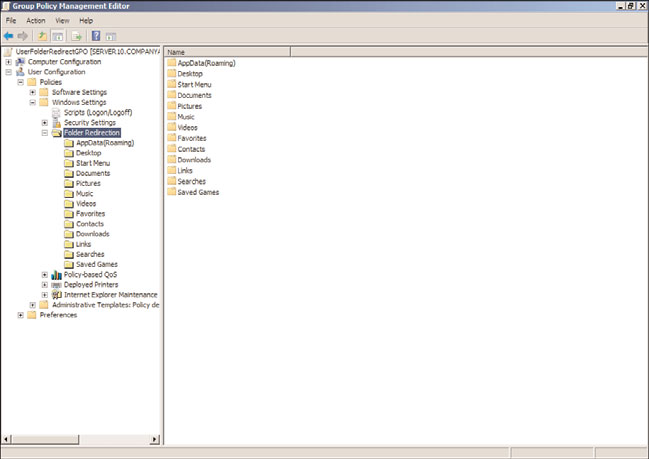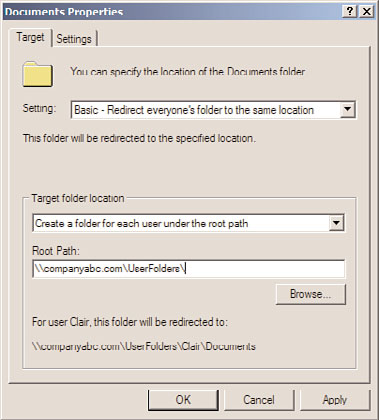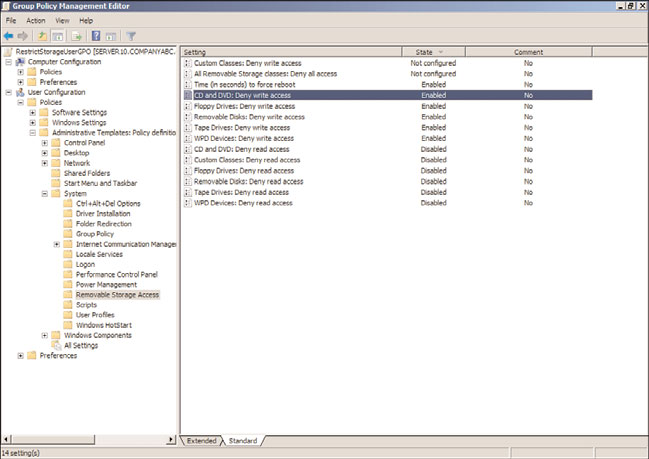Windows Server 2008 R2 Unleashed (210 page)
Read Windows Server 2008 R2 Unleashed Online
Authors: Noel Morimoto
users to store and access their data, can be redirected to server shares. The following are
some basic rule-of-thumb guidelines when using this Group Policy extension:
.
Allow the system to create the folders—
If the folders are created by the adminis-
trator, they will not have the correct permissions. But properly configuring the share
and NTFS permissions on the server share is essential in providing a functional
folder redirection experience.
1072
CHAPTER 27
Group Policy Management for Network Clients
.
Enable client-side caching or offline file synchronization—
This is important
for users with portable computers but is not the desired configuration for folder redi-
rection on Remote Desktop Services systems. Furthermore, when storing data on
end-user workstations, it may violate regulatory and/or security requirements to
allow for cached local copies.
.
Use fully qualified (UNC) paths or DFS paths for server share locations—
For
example, use \\Server1.companyabc.com\UserProfiles or
\\companyabc.com\UserProfiles\ if DFS shares are deployed.
Before folder redirection can be expected to work, share and NTFS permissions must be
configured appropriately. For folder redirection to work properly, configure the NTFS as
follows:
. Configure the share folder to not inherit permissions and remove all existing
permissions.
. Add the file server’s local Administrators group with Full Control of This Folder,
Subfolders, and Files.
. Add the Domain Admins domain security group with Full Control of This Folder,
Subfolders, and Files.
ptg
. Add the System account with Full Control of This Folder, Subfolders, and Files.
. Add the Creator/Owner with Full Control of Subfolders and Files.
. Add the Authenticated Users group with both List Folder/Read Data and Create
Folders/Append Data – This Folder Only rights. The Authenticated Users group can
be replaced with the desired group, but do not choose the Everyone group as a
best practice.
The share permissions of the folder can be configured to grant administrators Full Control
and Authenticated Users Change permissions.
To redirect the Documents folder to a network share for Windows Vista, Windows 7,
Windows Server 2008, and Windows Server 2008 R2 systems, perform the following steps:
1. Log on to a designated Windows Server 2008 R2 administrative server.
2. Click Start, click All Programs, click Administrative Tools, and select Group Policy
Management.
3. Add the necessary domains to the GPMC as required.
4. Expand the Domains node to reveal the Group Policy Objects container.
5. Create a new GPO called UserFolderRedirectGPO and open it for editing.
6. After the UserFolderRedirectGPO is opened for editing in the Group Policy
Management Editor, expand the User Configuration node, expand Policies, expand
Windows Settings, and select the Folder Redirection node to display the user profile
folders that are available for redirection, as shown in Figure 27.19. Keep in mind

Managing Users with Policies
1073
that the folders in this section and detailed in Figure 27.19 represent the folders
available in Windows Vista, Windows 7, Windows Server 2008, and Windows Server
2008 R2 user profiles. If Windows 2000, Windows XP, or Windows Server 2003
profiles require folder redirection, configuring the Documents folder for redirection
is supported work but will require additional testing against each edition and service
pack level of the legacy operating system that the policy applies to.
ptg
27
FIGURE 27.19
Windows Server 2008 R2 and Windows Vista folder redirection.
7. In the Settings pane, right-click the Document folder and select Properties.
8. On the Target tab, click the Setting drop-down list arrow, and select Basic – Redirect
Everyone’s Folder to the Same Location, which reveals additional options. There is
another option to configure folder redirection to different locations based on group
membership, but for this example, select the basic redirection option.
9. In the Target Folder Location section, there are several options to choose from and
each should be reviewed for functionality; for this example, select Create a Folder for
Each User Under the Root Path. This is very important if multiple folders will be
redirected; more details are explained in the following steps.
10. In Root Path field, type in the server and share name, for example
\\companyabc.com\UserFolders, as shown in Figure 27.20. Notice how the end-user
name and Document folder will be created beneath the root share folder. This
requires that the end users have at least Change rights on the share permissions and
they must also have the Create Folder and Create File NTFS permissions on the root
folder that is shared.

1074
CHAPTER 27
Group Policy Management for Network Clients
FIGURE 27.20
Folder redirection with basic redirection to a target root folder.
ptg
11. Select the Settings tab and uncheck the Grant the User Exclusive Rights to
Documents check box. If necessary, check the check box to also apply redirection to
Windows 2000, Windows XP, and Windows Server 2003 operating systems.
12. Click OK to complete the folder redirection configuration. A warning pop-up opens
that states that this policy will not display the Folder Redirection node if an admin-
istrator or user attempts to configure or view this group policy using policy manage-
ment tools from Windows 2000, Windows XP, or Windows Server 2003. Click Yes to
accept this warning and configure the folder redirection.
13. Back in the Group Policy Management Editor window, close the GPO.
14. In the GPMC, link the new UserFolderRedirectGPO policy to an OU with a user
account that can be used to test this policy.
15. Log on to a Windows Vista, Windows 7, or a Windows Server 2008 system with the
test user account. After the profile completes loading, click the Start button, and
locate and right-click the Documents folder. Select the Location tab and verify the
path. For example, for a user named Khalil, the path should be
\\companyabc.com\UserFolders\Khalil\Documents.
If the folder is not redirected properly, the Windows Vista or later system might need to
have a domain policy applied that forces Synchronous Foreground Refresh of group poli-
cies. Also a very common configuration error is the NTFS and share permissions on the
root folder. In most cases, however, a few logons by the particular user will get the settings
applied properly.

Managing Users with Policies
1075
Each of the default folder redirection folders will automatically be configured to synchro-
nized with the server and be available offline. When additional server folders need to be
configured to be available offline, perform the following steps:
1. Locate the shared network folder that should be made available offline.
2. Right-click the folder and select Always Available Offline.
As long as the server share allows offline synchronization and the client workstation also
supports this, as they both do by default, that is all that is necessary.
Removable Storage Access
Windows Server 2008 R2, Windows Vista, and Windows 7 group policies provide several
settings that can be used to control how removable devices and removable storage can be
used. Some of these settings apply to CD and DVD drives and media, but many are
designed to control the read and write permission to removable disks such as external USB
drives and memory sticks. These settings can be configured in a computer group policy
but can also be configured in the User Configuration node to deny write access to remov-
able media, as shown in Figure 27.21. The settings are located in User
Configuration\Policies\Administrative Templates\System\Removable Storage Access.
ptg
27
FIGURE 27.21
Restricting write access to removable storage for users.
Managing Microsoft Management Console Access
Microsoft has standardized the deployment of management and configuration tools to use
Microsoft Management Console (MMC) snap-ins. By default, all users can open a blank
MMC and add snap-ins to the console. The snap-ins loaded on a particular machine are
1076
CHAPTER 27
Group Policy Management for Network Clients
the only ones that can be added. Having access to each snap-in can unnecessarily expose
configuration information to undesired individuals. Also, depending on the function of
the snap-in, functions might be available to standard users that can impact the perfor-
mance of production systems. For example, a user can add the Active Directory Users and
Computers snap-in to an MMC console and can then create queries that run against the
domain controller, causing unnecessary load on the system. To restrict access to the MMC
or specific MMC snap-ins using domain group policies, perform the following steps:
1. Log on to a designated Windows Server 2008 R2 administrative server.
2. Open the Group Policy Management Console from the Administrative Tools menu.
3. Add the necessary domains to the GPMC as required.
4. Expand the Domains node to reveal the Group Policy Objects container.
5. Either create a new GPO or edit an existing GPO.
6. After the GPO is opened for editing in the Group Policy Management Editor,
expand the User Configuration node, expand the Policies node, and select
Administrative Templates.
7. Expand the Administrative Templates node and select Windows Components.
8. Scroll down and select Microsoft Management Console in the tree pane. Expand this
node to reveal the Restricted/Permitted Snap-Ins node and select it.
ptg
9. With the Restricted/Permitted Snap-Ins node selected in the tree pane, a list of well-
known snap-ins is displayed in the Settings pane. Select and open the Active
Directory Users and Computers snap-in. Configure the setting to Disabled to block
the use of this snap-in for the users to whom this policy will apply and click OK.
10. After the snap-in is disabled, close the policy and link it to the desired OU that con-
tains the users who need to be restricted from using the disabled snap-in.
Managing Active Directory with Policies
Many Group Policy settings detailed in the previous sections of this chapter for computer